Key takeaways:
- Smart surveillance technology enhances peace of mind by providing real-time alerts and insights into activity patterns.
- Integration of smart devices improves overall security, with examples such as connecting smart doorbells and surveillance cameras.
- Data security is crucial, with measures like encryption, multi-factor authentication, and regular updates ensuring device protection.
- The future of surveillance technology focuses on AI and privacy, balancing effective monitoring with respect for individual rights.
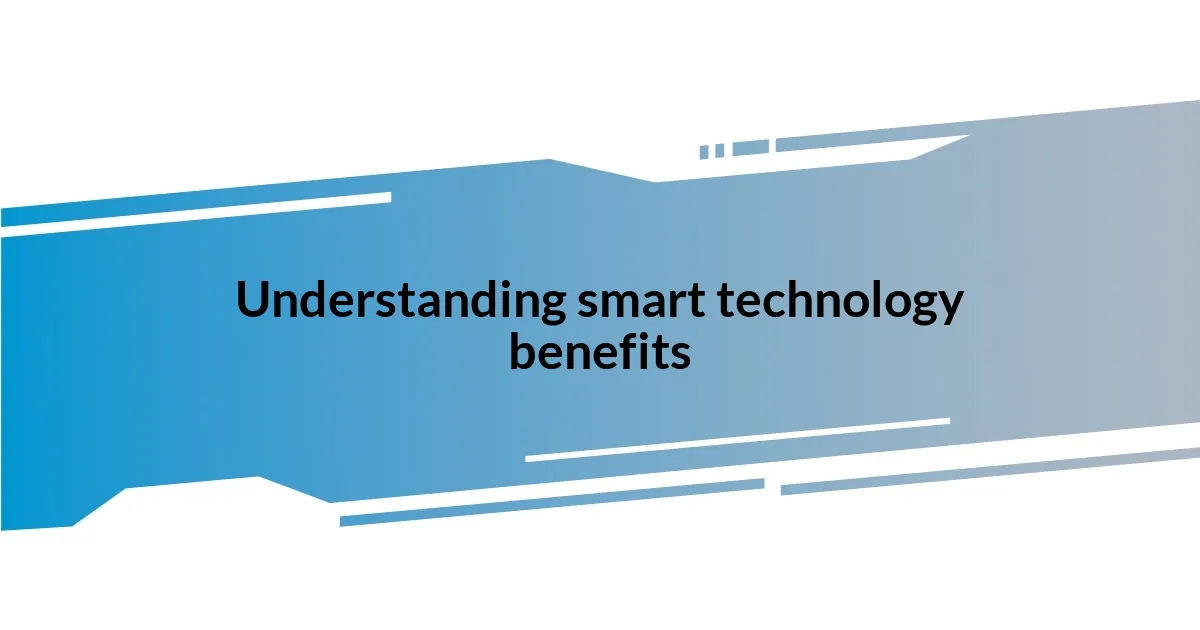
Understanding smart technology benefits
One of the most significant benefits I’ve noticed with smart technology in surveillance is the heightened peace of mind it provides. For instance, I installed smart cameras around my home that send real-time alerts to my phone. It’s incredible how just knowing I can monitor my space from anywhere instantly eases anxiety about safety.
With smart surveillance systems, data analysis becomes effortless and incredibly insightful. I remember when my system flagged unusual activity in a specific area of my yard. What I initially thought was an animal turned out to be a potential security concern, allowing me to act before things escalated. Isn’t it amazing how technology can keep us one step ahead by detecting patterns we might miss?
Moreover, integration of smart technology dramatically improves adaptability. By using features like facial recognition and motion tracking, I’ve tailored my system to only alert me about significant events. This customization not only saves time but also helps in focusing my attention where it truly matters. Have you ever thought about how empowering it is to have technology that learns and evolves alongside your needs?
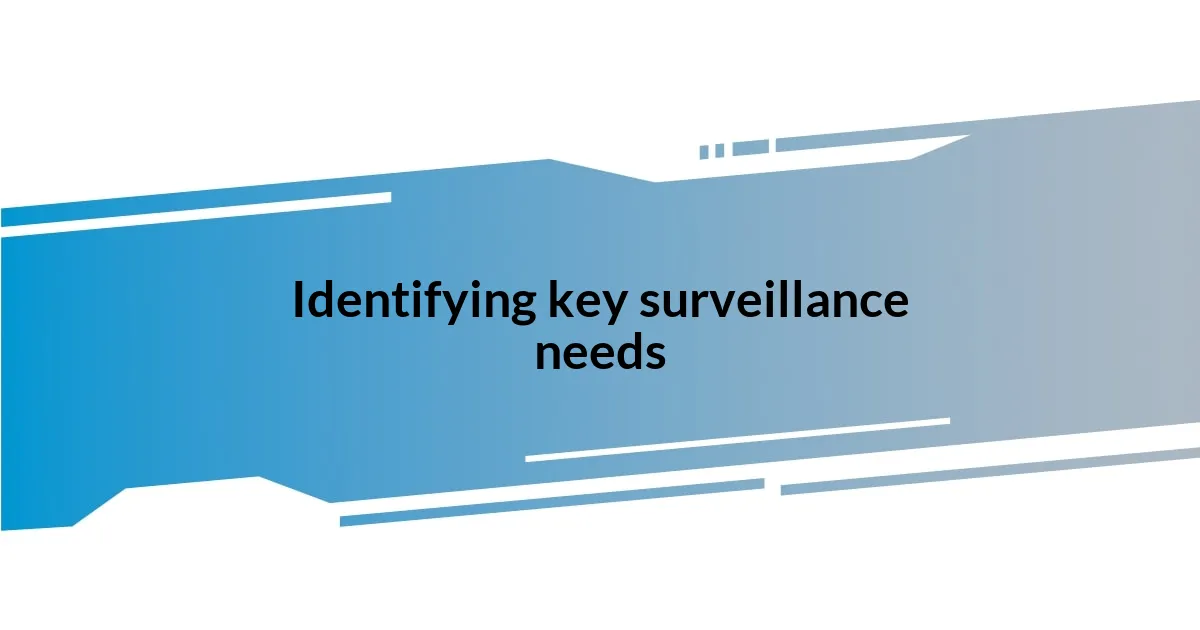
Identifying key surveillance needs
Identifying key surveillance needs is crucial for effectively integrating smart technology. I’ve found that understanding the specific requirements of my environment helps me choose the right devices and features. For example, in my case, I realized that outdoor surveillance was necessary due to previous incidents in my neighborhood. This focus on outdoor protection led me to invest in high-definition cameras with night vision capabilities.
In addition to physical security, I’ve learned that monitoring the well-being of loved ones is vital. After my aging parents moved in with me, I recognized the importance of keeping an eye on their activities without intruding on their privacy. Using indoor smart cameras equipped with two-way audio allowed me to check in on them while providing peace of mind. It’s heartwarming to know they’re safe, and it keeps me connected to their daily routines, even when I’m busy.
Lastly, assessing the integration of surveillance with other smart home devices can enhance overall security. I remember connecting my smart doorbell to my security system, enabling me to see who’s at the door before opening it. This simple setup not only increased convenience but also significantly improved safety. Have you considered how different elements of technology can complement each other to suit your unique surveillance needs?
| Surveillance Need | Example Solution |
|---|---|
| Outdoor Security | HD Cameras with Night Vision |
| Monitoring Loved Ones | Indoor Cameras with Two-Way Audio |
| Integration with Smart Devices | Smart Doorbell Linked to Security System |
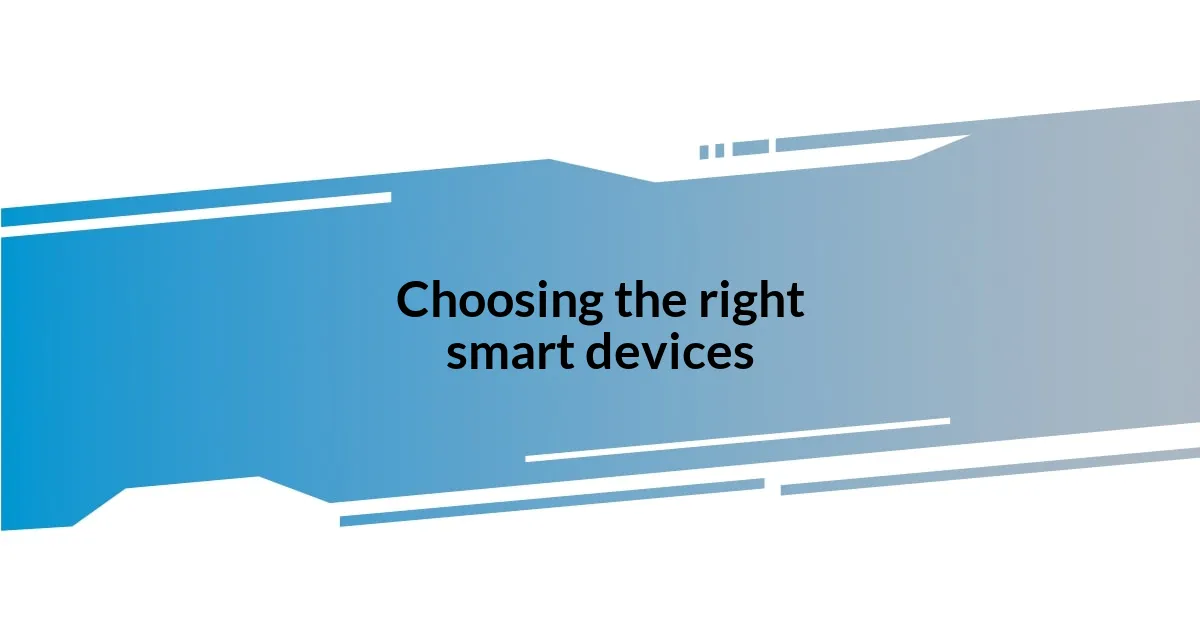
Choosing the right smart devices
Choosing the right smart devices requires careful consideration and alignment with your unique needs. Personally, I found that starting with a detailed list of priorities made all the difference. For example, when I considered adding a smart lock, I realized convenience and security had to go hand in hand for me. Balancing those features not only gave me peace of mind but also transformed how easily I managed access to my home.
Here’s a quick checklist to help you choose the right smart devices for your surveillance setup:
- Compatibility: Ensure devices work well together and with your existing systems.
- Quality: Prioritize high-resolution cameras for detailed footage.
- Features: Look for advanced options such as motion detection and night vision.
- User-Friendliness: Choose devices that are easy to set up and control.
- Data Security: Verify that the devices have strong encryption and privacy settings.
In my experience, trying to integrate devices that don’t mesh well can lead to frustration, so aim for synergy. For instance, when I opted for a smart surveillance camera that integrated seamlessly with my existing home automation system, it felt like a game-changer. I was instantly able to monitor and control everything from a single app, which not only simplified my routine but also made me feel more in control of my home’s safety. Every feature should work for you, not the other way around.
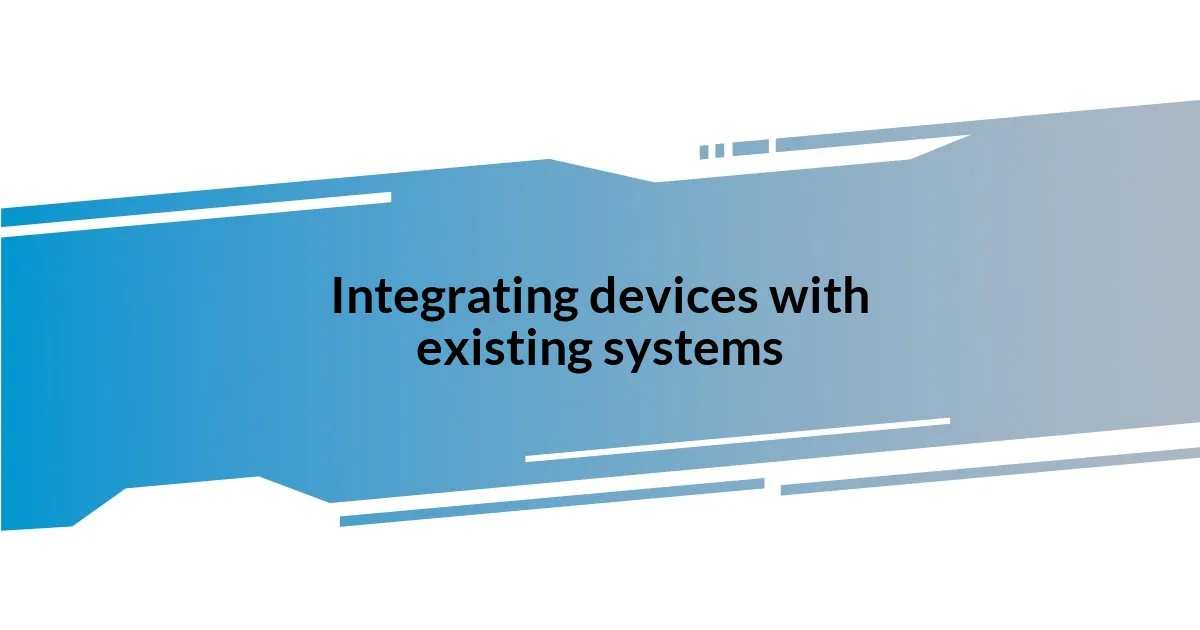
Integrating devices with existing systems
Integrating new devices into existing systems can initially feel daunting, especially if you’re not particularly tech-savvy. I remember when I decided to add smart floodlights to my outdoor setup—they needed to mesh well with my previous equipment. By carefully reviewing the compatibility specifications, I was thrilled to find devices that synced effortlessly with my current surveillance system. This seamless integration not only expanded my monitoring capabilities but also created a more cohesive security strategy.
It’s fascinating how the right connections can enhance functionality. For example, when I linked my smart thermostats with my security cameras, I gained valuable insights on energy usage patterns right along with my safety monitoring. Plus, these little integrations had an unexpected benefit: I often received alerts about unusual activity whenever a change in temperature settings was detected, adding another layer of security. Have you noticed how interconnected devices can amplify their effectiveness when working harmoniously together?
One of the most rewarding moments came after integrating a motion sensor with my existing security camera. It felt like my home transformed overnight. The combination allowed me to receive instant alerts on my phone whenever movement was detected, dramatically improving my home vigilance. I was surprised at how this simple addition relieved my anxiety, especially at night. With technology working in tandem, it became easy to rest easy knowing that every corner of my home had a watchful eye without extra hassle.
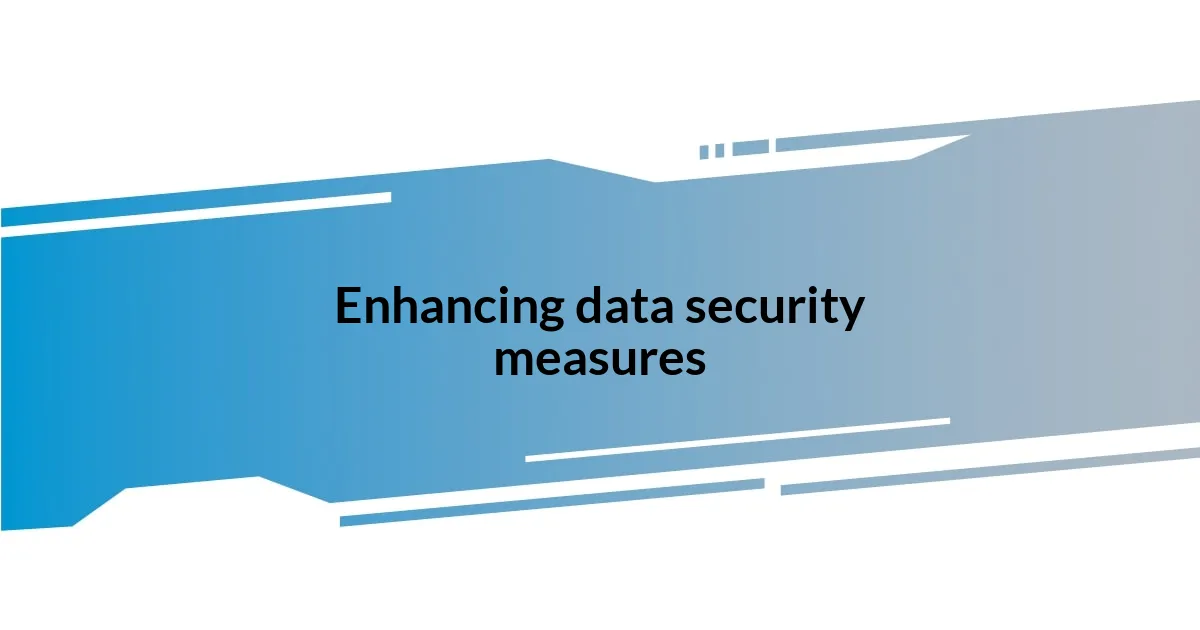
Enhancing data security measures
Enhancing data security measures is critical in today’s tech-driven landscape. I can vividly recall my initial hesitations when setting up an encryption protocol for my smart devices. After doing some research, I realized the importance of data encryption. This small step made a world of difference, making me feel far more secure knowing that the footage captured by my cameras was harder for unauthorized parties to access.
One of my most eye-opening experiences was discovering multi-factor authentication. I remember the moment I activated it on my security app; it felt like putting on an extra lock. This feature sent a code to my phone every time I logged in, providing an extra layer of protection. Have you ever found yourself questioning the security of your personal data? I definitely have, and implementing such measures not only alleviated my concerns but also empowered me to take charge of my digital safety.
Regular updates are another essential aspect of enhancing data security that I underestimated at first. Once, I neglected an update because I thought it was merely routine—and it turned out to be a pivotal mistake. That same week, there were reports of vulnerabilities in outdated devices that were subsequently exploited. Now, I make it a habit to enable automatic updates, knowing that keeping my devices fresh and protected is a simple but effective way to guard against potential breaches. It’s a bit like maintaining the locks on your door—if they aren’t functioning properly, what’s the point?
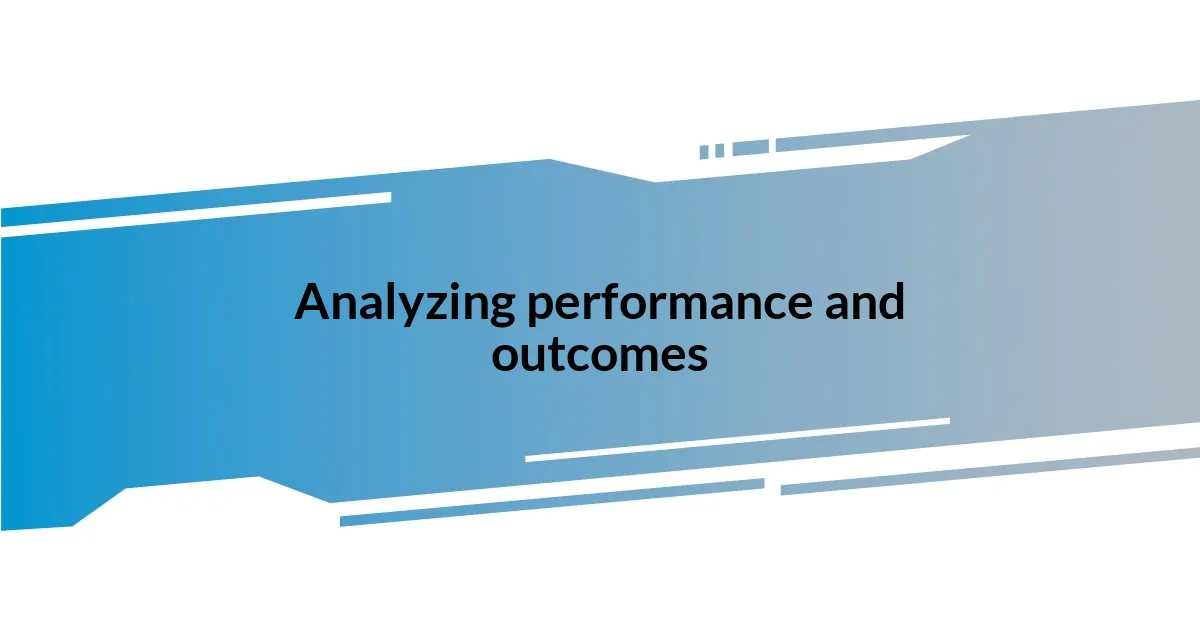
Analyzing performance and outcomes
When it comes to analyzing performance and outcomes, I often find myself reflecting on the tangible benefits these technologies bring. For instance, after integrating smart cameras with cloud storage, I was amazed by how easily I could review footage from anywhere, anytime. This not only helped me assess any incidents more effectively but also illuminated patterns of activity that I never noticed before.
I vividly recall a moment when my system alerted me to repeated visits from a delivery person at odd hours. This not only provided reassurance regarding the efficiency of my surveillance but also prompted me to adjust my delivery times to prevent potential issues. Have you ever thought about how such seemingly minor adjustments can lead to significant insights? It’s fascinating how smart technology can help refine daily routines and enhance overall safety.
One of the most rewarding aspects has been the ability to gather data for future improvements. By regularly examining the reports generated by my security system, I’ve pinpointed vulnerable areas that needed better coverage. This proactive approach not only increased my peace of mind but also allowed me to invest wisely in additional devices, transforming my setup from reactive to proactive. Isn’t it empowering to take control over your safety?
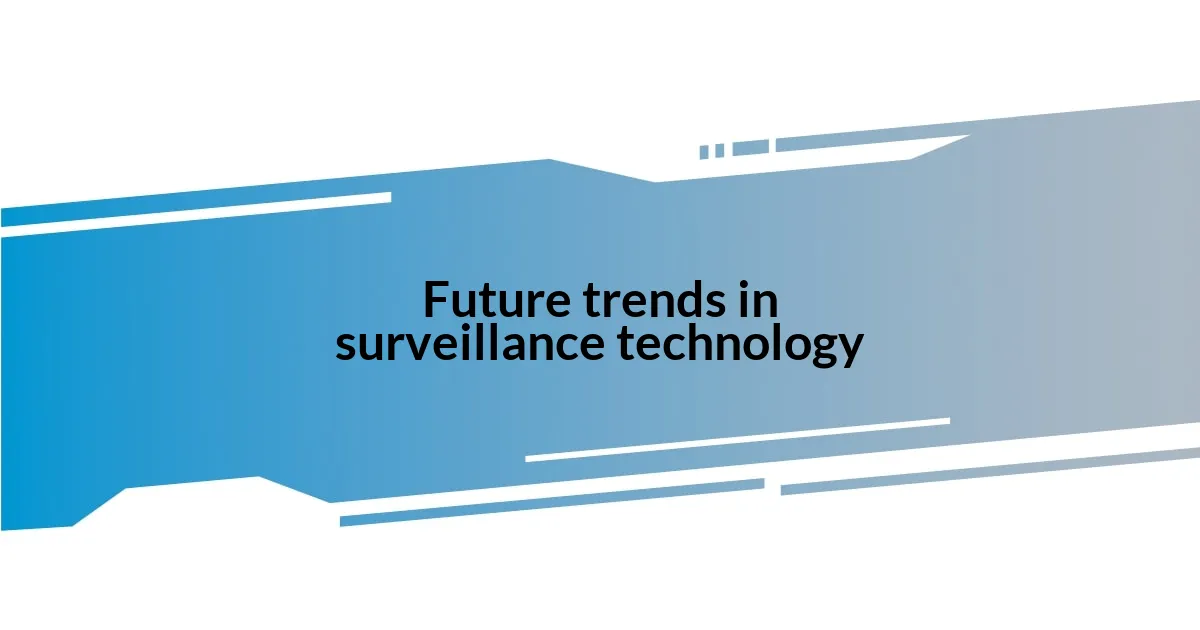
Future trends in surveillance technology
It’s fascinating to think about how artificial intelligence (AI) is revolutionizing surveillance technology. From my experience, implementing AI-powered cameras has transformed how I monitor my surroundings. They now not only record footage but can analyze behavior in real time, distinguishing between normal activities and suspicious movements. Have you ever imagined a system that could alert you instantly if something feels off? I certainly didn’t expect the level of convenience and security these intelligent systems would provide.
As I’ve delved deeper into smart technology, I’ve noticed a growing trend towards integrating Internet of Things (IoT) devices into surveillance solutions. For instance, my system now connects seamlessly with smart lights and alarms, creating a more interconnected safety net. This synergy enhances responsiveness; if a camera detects unusual motion, my lights can flash or alarms can sound off automatically. It’s almost as if these devices communicate a silent yet powerful language of protection. Isn’t it intriguing how technology can work together to amplify our sense of security?
Looking ahead, I’m excited about the shift towards privacy-focused surveillance technologies. My initial fears about constant monitoring have eased as I’ve learned more about protocols that prioritize individual privacy, like local data storage and anonymization. These advancements aim to balance effective monitoring with personal privacy rights—a crucial consideration in today’s world. Have you ever pondered the fine line between security and privacy? It’s reassuring to know that the future of surveillance technology might respect that boundary while still keeping us safe.